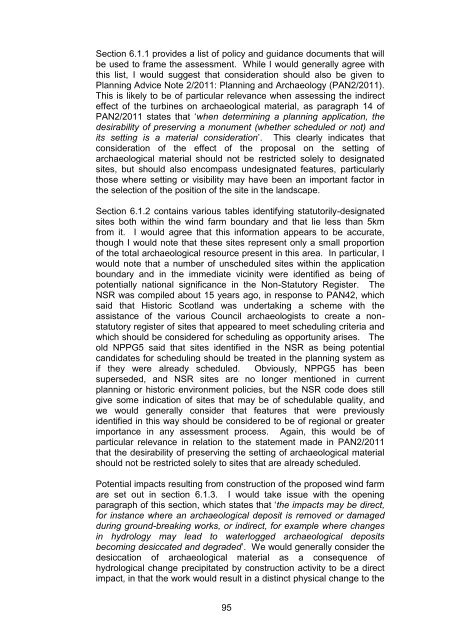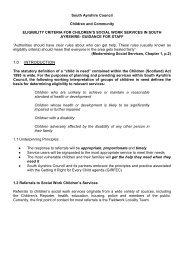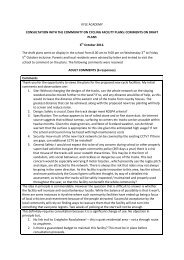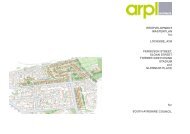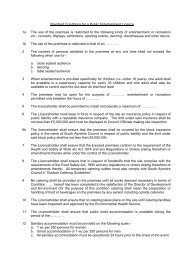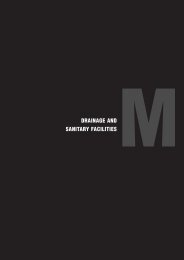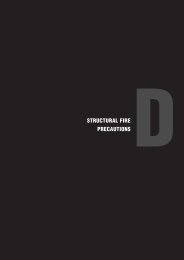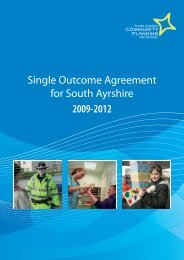Glenmount Wind Farm - South Ayrshire Council
Glenmount Wind Farm - South Ayrshire Council
Glenmount Wind Farm - South Ayrshire Council
You also want an ePaper? Increase the reach of your titles
YUMPU automatically turns print PDFs into web optimized ePapers that Google loves.
Section 6.1.1 provides a list of policy and guidance documents that will<br />
be used to frame the assessment. While I would generally agree with<br />
this list, I would suggest that consideration should also be given to<br />
Planning Advice Note 2/2011: Planning and Archaeology (PAN2/2011).<br />
This is likely to be of particular relevance when assessing the indirect<br />
effect of the turbines on archaeological material, as paragraph 14 of<br />
PAN2/2011 states that ‘when determining a planning application, the<br />
desirability of preserving a monument (whether scheduled or not) and<br />
its setting is a material consideration’. This clearly indicates that<br />
consideration of the effect of the proposal on the setting of<br />
archaeological material should not be restricted solely to designated<br />
sites, but should also encompass undesignated features, particularly<br />
those where setting or visibility may have been an important factor in<br />
the selection of the position of the site in the landscape.<br />
Section 6.1.2 contains various tables identifying statutorily-designated<br />
sites both within the wind farm boundary and that lie less than 5km<br />
from it. I would agree that this information appears to be accurate,<br />
though I would note that these sites represent only a small proportion<br />
of the total archaeological resource present in this area. In particular, I<br />
would note that a number of unscheduled sites within the application<br />
boundary and in the immediate vicinity were identified as being of<br />
potentially national significance in the Non-Statutory Register. The<br />
NSR was compiled about 15 years ago, in response to PAN42, which<br />
said that Historic Scotland was undertaking a scheme with the<br />
assistance of the various <strong>Council</strong> archaeologists to create a nonstatutory<br />
register of sites that appeared to meet scheduling criteria and<br />
which should be considered for scheduling as opportunity arises. The<br />
old NPPG5 said that sites identified in the NSR as being potential<br />
candidates for scheduling should be treated in the planning system as<br />
if they were already scheduled. Obviously, NPPG5 has been<br />
superseded, and NSR sites are no longer mentioned in current<br />
planning or historic environment policies, but the NSR code does still<br />
give some indication of sites that may be of schedulable quality, and<br />
we would generally consider that features that were previously<br />
identified in this way should be considered to be of regional or greater<br />
importance in any assessment process. Again, this would be of<br />
particular relevance in relation to the statement made in PAN2/2011<br />
that the desirability of preserving the setting of archaeological material<br />
should not be restricted solely to sites that are already scheduled.<br />
Potential impacts resulting from construction of the proposed wind farm<br />
are set out in section 6.1.3. I would take issue with the opening<br />
paragraph of this section, which states that ‘the impacts may be direct,<br />
for instance where an archaeological deposit is removed or damaged<br />
during ground-breaking works, or indirect, for example where changes<br />
in hydrology may lead to waterlogged archaeological deposits<br />
becoming desiccated and degraded’. We would generally consider the<br />
desiccation of archaeological material as a consequence of<br />
hydrological change precipitated by construction activity to be a direct<br />
impact, in that the work would result in a distinct physical change to the<br />
95


